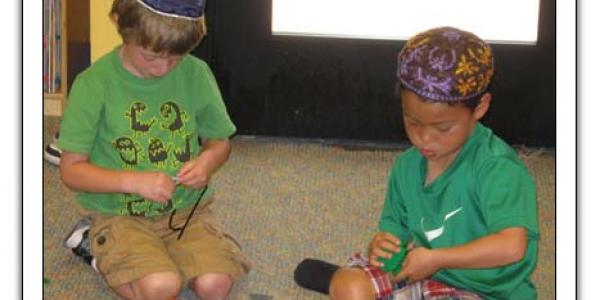Transitions to Kindergarten

You are here
Going to kindergarten is an important life event. Preschoolers can feel excited—and a bit worried, too. Families have similar feelings, knowing their child is going to the “big school.” Preschool teachers want the children in their classrooms to be ready for kindergarten. In this article, we’ll give you some tips to help children prepare. Some ideas are for children who will move to a new elementary school. Others are for children who will stay in the same building, usually a pre-K to elementary setting. You’ll also find suggestions to support families so they can help their children with the transition.
For children who are moving to a new school
- Talk with the children about their feelings about the change. Share your own feelings, too. Children should have many opportunities to talk about their fears and concerns. It is okay to say you will miss them and that you are also proud they are growing up and moving on.
- Write and illustrate a class book about children’s and teachers’ feelings about going to kindergarten.
- Invite a kindergarten teacher to visit your program to explain what happens in kindergarten and answer questions. Prepare the children beforehand. If you have not done so yet, introduce the K-W-L format (what we know, what we want to know, what we have learned).
- Make a list of the children’s ideas about what kindergarten is like.
- Support the children who are going to different schools. Ask parents to take photographs of the school the children will attend and share them with the class. Use them to lead a discussion about what to expect.
- Make a bulletin board about kindergarten using all the photographs and comments from the children.
For children who are going to kindergarten in the same school
Visit the kindergarten class or classes several times throughout the year to make for a smoother transition. When preschool and kindergarten classes do joint activities, the preschoolers tend to feel more comfortable when moving on to kindergarten.
For the families
In addition to these ideas for easing the children’s transition to their new classroom, we also have some suggestions to help families. It is our role as early childhood educators to help families understand what kindergarten readiness really means. Children who are ready for kindergarten can take care of personal needs such as hand washing and going to the bathroom. They have the motor skills needed for activities requiring coordination and balance, such as bike riding, skipping, or participating in team sports. They have developed the small muscle coordination needed to hold and write with a pencil or other tool. In addition, they can regulate their own behavior and express their feelings with words, and can learn math, reading, and other academic skills at the kindergarten level.
Supporting learning at home
Most families already do activities at home that support their children’s experiences and learning in your program. However, it is always helpful to provide reminders of some of the simple tasks that water the seeds of lifelong learning. Encourage families to
- Read to their child every day
- Provide crayons for drawing and scissors for cutting
- Do playful number activities such as counting, telling the number before and after a quantity, and telling how much you have when there is one more or one less than a quantity
- Offer markers, Legos, and other small manipulatives to support development of their child’s grasp and fine motor coordination
- Give their child opportunities to make decisions and smart choices
- Institute early bedtimes and provide healthy meals
Reaching out
You can help support families by reminding them of kindergarten orientation and open house dates in your area. Families can support kindergarten transition activities with their child. They can
- Attend an open house in the fall (many schools have these)
- Attend orientation in the spring
- Visit the school and meet the kindergarten teacher
- Shop for school supplies (teachers typically provide a list)
Communication between teachers
In addition to thinking about children and families, it is also good for preschool and kindergarten teachers to network, share information, and do joint planning. The initiative may be started by either group of teachers. In some locations, there are kindergarten discussion groups in which preschool, kindergarten, and first grade teachers get together to talk about common issues. This networking shows families that teachers are working together to ensure all children learn and make progress toward achieving early learning standards. It is reassuring to families to know that if children are ready to enter kindergarten, they will also be able to meet kindergarten standards throughout the year.
Angèle Sancho Passe is an early education consultant, trainer, and writer based in Minneapolis, Minnesota, and a past member of the NAEYC Governing Board. She is the author of Dual Language Learners, which includes additional information on how families can help their children become bilingual.